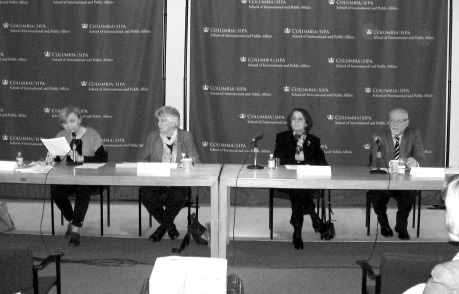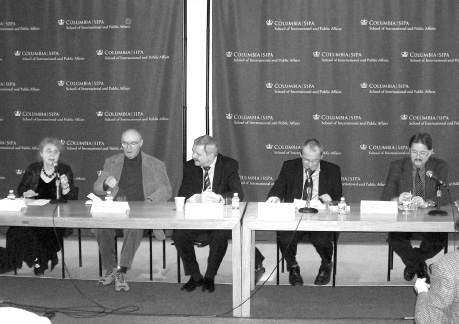Legacy of Non-Conformism
& Dissent in Soviet Bloc
By
Christina Isajiw
 We gathered like veterans revisiting
old battlegrounds to examine the motives, inspiration and heroism of dissent in
the Soviet Bloc, trying to assess whether the legacy of dissident values survived
and where. Nonconformism and Dissent in the Soviet Bloc: Guiding Legacy or Passing
Memory” was a conference held March 30-April 1, 2011, organized by the Ukrainian
Studies Program, Harriman Institute, Columbia University, in collaboration with
the East Central European Center (Columbia University), the Polish Cultural Institute
(New York) and the Ukrainian Museum. This significant review and recollection examined
a wide scope of issues and discussed how the legacy of important socio-political
ideas and movements can be preserved and transmitted across eras of political regimes.
We gathered like veterans revisiting
old battlegrounds to examine the motives, inspiration and heroism of dissent in
the Soviet Bloc, trying to assess whether the legacy of dissident values survived
and where. Nonconformism and Dissent in the Soviet Bloc: Guiding Legacy or Passing
Memory” was a conference held March 30-April 1, 2011, organized by the Ukrainian
Studies Program, Harriman Institute, Columbia University, in collaboration with
the East Central European Center (Columbia University), the Polish Cultural Institute
(New York) and the Ukrainian Museum. This significant review and recollection examined
a wide scope of issues and discussed how the legacy of important socio-political
ideas and movements can be preserved and transmitted across eras of political regimes.
In his keynote address, Myroslav
Marynovych discussed the “Moral Aspects of the Dissident Resistance in Ukraine”, where
he praised the solidarity and brotherhood that characterized dissidents in the Gulag
and posited the spiritual transformation that became a part of every dissident.
Four panels addressed topics of historical overview, documenting and researching
dissident movements, the legacies of non-conformism and dissent, and its impact
in contemporary society and politics (Christina Isajiw, Jeri Laber, Anna Procyk,
Frank Sysyn, Ksenia Kiebuzinski, Ann Komaromi, Benjamin Nathans, Michael Bernhard,
Alex Motyl, Peter Reddaway, Mark Andryczyk, Justyna Beinek, and Catharine Nepomnyashchy),
while two roundtables (Pavel Litvinov, Myroslav Marynovych, Henryk Wujec, Volodymyr
Dibrova, Vitaly Komar, Mykola Riabchuk and Ewa Wojciak) took up the issues from
the perspective of former dissidents and non-conformist cultural figures.
 The political context in which
dissent grew from the mid-1950s and indeed the dissident movement from the 1960s
to the late 1980s, were not well known in the West and well hidden from their own
people by authorities in the Soviet Bloc. Various papers examined how the dogmatic
and all embracing ideology interlocked with the Communist Party to permeate everyone’s
daily life, where there was no freedom of expression or public association, and
no freedom of movement, either to leave the Soviet Union
or to move within. In this daunting context, dissidents were motivated by the ideals
of humanitarian, democratic, national, cultural, and religious freedom. They were
the young intellectuals: writers, journalists, academics, members of religious groups
and also workers, military individuals and even Communist Party members, who called
upon their governments demanding observance of their constitution. These were activists
who suffered repression, long years of incarceration, some confined to long terms
of forced psychiatric abuse, some suffered death, all to inspire such compelling
protests demanding change.
The political context in which
dissent grew from the mid-1950s and indeed the dissident movement from the 1960s
to the late 1980s, were not well known in the West and well hidden from their own
people by authorities in the Soviet Bloc. Various papers examined how the dogmatic
and all embracing ideology interlocked with the Communist Party to permeate everyone’s
daily life, where there was no freedom of expression or public association, and
no freedom of movement, either to leave the Soviet Union
or to move within. In this daunting context, dissidents were motivated by the ideals
of humanitarian, democratic, national, cultural, and religious freedom. They were
the young intellectuals: writers, journalists, academics, members of religious groups
and also workers, military individuals and even Communist Party members, who called
upon their governments demanding observance of their constitution. These were activists
who suffered repression, long years of incarceration, some confined to long terms
of forced psychiatric abuse, some suffered death, all to inspire such compelling
protests demanding change.
What recognition or support did
these brave proponents of human rights and national freedom enjoy after the fall
of the USSR?
Although very few individuals became involved in their country’s political life,
there was very little if no recognition by the Russian and Ukrainian post-USSR governments
of their lives and legacy. Indeed, the only tribute paid to them was done by Western
human rights groups and government representatives, and diaspora organizations working
on their behalf. In Ukraine and
Russia,
there are virtually no public memorials dedicated to dissidents of that period,
except on gravestones in cemeteries. As Mykola Riabchuk noted, “people are very
uncomfortable to be with (former) dissidents, perhaps because they feel guilty or
inferior – they were true to their beliefs and we were not.”
Documentation of personal and collective
courage to challenge and break Communist taboos, to undergo harassment, imprisonment
and exile and to survive, is still sparse. There are very few museums where this
era is placed in public view for scrutiny, learning and commemoration. Official
archives also vary greatly from country to country: a limited access to the KGB
material in Moscow
and a fully open policy to the official documents of the Lithuanian government,
for example. Much was said about the fact that there is still much work needed to
bring to light the “samvydav-samizdat” material as well as many of the still unpublished
memoirs. Of great importance are the documents, archives and yet to be published
memoirs of the work by Western Non-Governmental Organizations (NGOs).
Religion, according to several
speakers, played a large role in the prison camps. There was no religious freedom,
but in opposition to the official Soviet dictates of atheism, dissidents experienced
a spiritual transformation. Religion, therefore, played an important role in the
dissidents’ lives, as related by Marynovych and Wujec. “I became an ecumenist in
the labour camp. When Easter came, we all celebrated together - if separately, we
would have been further persecuted. Religion was part of our life,” said Marynovych.
“We would not have won without the help of the Church,” said Henryk Wujec, a co-founder
of Solidarity. “Priests held hunger strikes with their parishes, often collected
money. When Wojtyla became Pope (John Paul II) and said ‘Let the Spirit enter us
and change the World’, the reaction was huge. Workers held up Wojtyla’s image as
a shield – he supported Solidarity,” Wujec stated.
Much was also said about the strong
solidarity between all dissidents, prisoners in the Gulag, and those to be
persecuted in the countries within Soviet domination. Cooperation and dissemination
of information between the Moscow Helsinki Group and the Kyiv Helsinki Group, for
instance, enabled Western NGOs and government agencies to gather documentation and
help to apply pressure for change.
In the face of totalitarianism,
the only alternative was to write, sing and recite poetry, produce cinema, and form
grass-roots subversive cultures. Samizdat-Samvydav was the mechanism and
the core of the opposition movement, in spite of the fact that the KGB had a huge
system of tracking and documenting this activity. There were schemas and diagrams
of where the opposition writings came from, how they were distributed and by whom.
There was an operation where the KGB analyzed typewriter discrepancies in order
to identify the origin and therefore the writer. Dissident stance was to oppose
such oppression. At the core of what dissent is about, is saying “no”, according
to Alexander Motyl, who maintained that non-conformism triumphs in Ukraine - a country
that was essentially conformist. “For this stance, the apotheosis was the Orange
Revolution publicly saying no to the regime,” said Motyl. In this long-standing
legacy in Ukraine: resistance movements of WWII, the Underground Church, the repression
and indeed the elimination of intelligentsia, the enormous numbers of political
and religious prisoners, all cried out for a continuation of the dissident stance.
Saying no to the regime promoted values and beliefs for a transformation of people’s
approach in everyday life. Dissent formed movements that finally mobilized hundreds
of thousands of individuals, and according to Motyl, dissident stance will survive
even in the present “crummy authoritarian system.” This legacy will survive for the future.
PHOTOS
1
- Panel on “Nonconformism and Dissent: Historical Overview”. (L to R):
Christina Isajiw, Jeri Laber, Anna Procyk and Frank Sysyn (Moderator)
2
- Panel on “Dissidents’ Roundtable”. (L to R): Catharine Nepomnyashchy, Pavel
Litvinov, Myroslav Marynovych, Henryk Wujec, John Micgiel (interpreter)
 We gathered like veterans revisiting
old battlegrounds to examine the motives, inspiration and heroism of dissent in
the Soviet Bloc, trying to assess whether the legacy of dissident values survived
and where. Nonconformism and Dissent in the Soviet Bloc: Guiding Legacy or Passing
Memory” was a conference held March 30-April 1, 2011, organized by the Ukrainian
Studies Program, Harriman Institute, Columbia University, in collaboration with
the East Central European Center (Columbia University), the Polish Cultural Institute
(New York) and the Ukrainian Museum. This significant review and recollection examined
a wide scope of issues and discussed how the legacy of important socio-political
ideas and movements can be preserved and transmitted across eras of political regimes.
We gathered like veterans revisiting
old battlegrounds to examine the motives, inspiration and heroism of dissent in
the Soviet Bloc, trying to assess whether the legacy of dissident values survived
and where. Nonconformism and Dissent in the Soviet Bloc: Guiding Legacy or Passing
Memory” was a conference held March 30-April 1, 2011, organized by the Ukrainian
Studies Program, Harriman Institute, Columbia University, in collaboration with
the East Central European Center (Columbia University), the Polish Cultural Institute
(New York) and the Ukrainian Museum. This significant review and recollection examined
a wide scope of issues and discussed how the legacy of important socio-political
ideas and movements can be preserved and transmitted across eras of political regimes. The political context in which
dissent grew from the mid-1950s and indeed the dissident movement from the 1960s
to the late 1980s, were not well known in the West and well hidden from their own
people by authorities in the Soviet Bloc. Various papers examined how the dogmatic
and all embracing ideology interlocked with the Communist Party to permeate everyone’s
daily life, where there was no freedom of expression or public association, and
no freedom of movement, either to leave the
The political context in which
dissent grew from the mid-1950s and indeed the dissident movement from the 1960s
to the late 1980s, were not well known in the West and well hidden from their own
people by authorities in the Soviet Bloc. Various papers examined how the dogmatic
and all embracing ideology interlocked with the Communist Party to permeate everyone’s
daily life, where there was no freedom of expression or public association, and
no freedom of movement, either to leave the